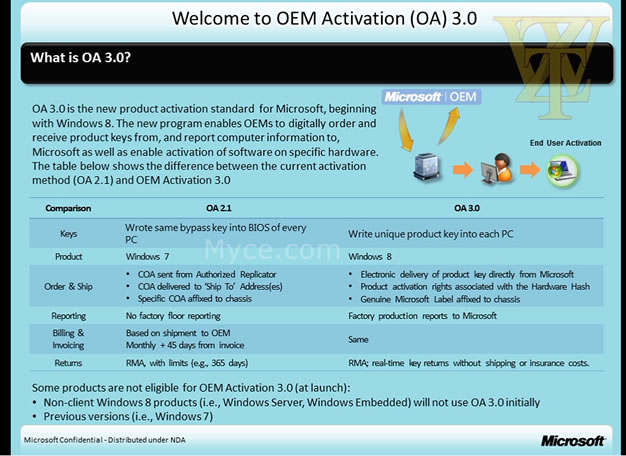Windows 8 to Feature New OEM Activation Method
OEMs will no longer used the same key for every Windows PC shipped.

Several NDA-tainted slides have been leaked that reveal a new activation process used by the OEM version of Windows 8. The new product activation standard is called OEM Activation 3.0 (AKA OA 3.0), and provides benefits over the previous version used in Windows 7, OA 2.1, such as allowing OEMs to digitally order and receive product keys directly from Microsoft.
For the uninitiated, the OA process allows PC manufacturers to ship systems with Windows pre-installed and already activated so that end users aren't required to take additional activation steps when they boot up their rig for the first time. Hackers usually take advantage of the OA process to activate pirated copies of Windows using fake license keys.
However hackers now face a new challenge. The leaked slides show the difference between the OA of old, and the new system that will be used in Windows 8. To crack down on piracy, manufacturers will be required to write a unique Windows product key -- which is associated with the hardware hash -- into the system's BIOS instead of using the same product key for every shipped desktop or laptop.
The new OA system will also require OEMs to supply production reports to Microsoft, detailing their license compliance. A "Genuine Microsoft" label must also be affixed to the chassis, dumping the previous "Windows Certificate of Authenticity" sticker. Unused keys can be returned in real-time without shipping or insurance costs, according to the leaked slides.
"OA 3.0 is the new product activation standard for Microsoft, beginning with Windows 8," one slide states. "The new program enables OEMs to digitally order and receive product keys from, and report computer information to, Microsoft as well as enable activation of software on specific hardware."
In comparison, OA 2.1 allowed OEMs to write the same bypass key into the BIOS of every shipped PC. The Certificate of Authenticity was shipped from an authorized replicator and sent to the OEM's shipping address. When received, they were required to be affixed to the chassis (just like the current label). OEM's were not required to send production reports, and the RMA had limitations.
Products not eligible for OA 3.0 at launch include non-client Windows 8 products (Windows Server, Windows Embedded), and previous version of the OS including Windows 7, Vista and others. To see the additional leaked slides, head here.
Get Tom's Hardware's best news and in-depth reviews, straight to your inbox.

Kevin Parrish has over a decade of experience as a writer, editor, and product tester. His work focused on computer hardware, networking equipment, smartphones, tablets, gaming consoles, and other internet-connected devices. His work has appeared in Tom's Hardware, Tom's Guide, Maximum PC, Digital Trends, Android Authority, How-To Geek, Lifewire, and others.
-
nitrium I Imagine that KMS/Rearm exploits (which are almost impossible to block) will be the first methods released, followed by hacked .dll files associated with Genuine verification a it later. My guess is a "working" pirated Win8 will be available by the end of this month.Reply -
tiang Should be short period of time to get the activation method. Wait and see for the miracle from the mighty hackers.Reply -
halcyon There are weird people out there...even those that would want to pirate Windows 8. Really? Really?Reply -
CaedenV DarkenMoon97I thought that PC's didn't use the same key before..Before they had a much simpler approach of selling a single key to the OEM. The OEM would then purchase COAs from MS that they would affix to the case of the computer, and would be used to register and track changes over time and piracy.Reply
This new system sounds like they will get a box of generic stickers instead of COAs, and instead of having a separate licence, activation key, and COA number, there will simply be a single # that is digitally purchased and assigned to the box which will then track the box throughout the life-cycle of the machine. This is perfectly fine for OEMs, and should actually make their jobs a little simpler on the logistics side of inventory and orders, while making the setup side a little harder. For MS this means that it will be much easier to track individual boxes, and their hardware changes over time, and if they get cash hungry then they can crack down on reactivation after upgrades and such (something that up until now they have been fairly generous with).
I really wonder how this will work for refurbishers like the company I work for. We take old computers, and MS gives us an extremely generous discount so that we can put a fresh legal copy of Windows on the machine that is tied to us (instead of the OEM such as Dell, HP, etc.). For some machines we are just putting XP back on them, while other higher-end XP and Vista boxes are getting Win7 instead. I am sure that MS will still have some form of vehicle for us to be able to provide the service that we do, but when win8 boxes start coming our way, I wonder if we will be forced then to re-use the same OS, or if we will be able to 'downgrade' to win7.
Personally I like win8 a lot, but the user base that we work with are quite computer illiterate and have a very difficult time moving from XP to 7 (which is essentially the same thing when it comes to web browsing and program launching). Moving from XP to 8 would be... traumatic at best. But time will tell, and I suppose this is what we have training classes for... -
The first few BIOS updates will overwrite the unique product key screwing over the consumer royally.Reply
Then there will be malware/scareware that will overwrite the key and popup a screen saying you need to pay so much to restore.